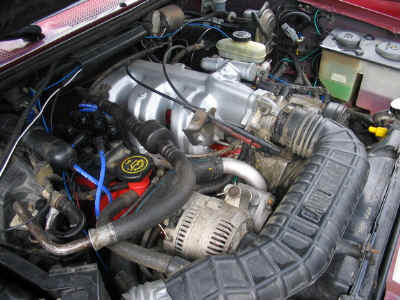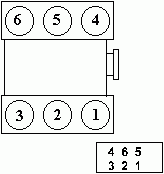
The 4.0L OHV (Over Head Valve) V-6 engine found its way in to the Ford Ranger in 1990 and ultimately replaced the 2.9L V-6. This evolutionary redesign of the American 2.9L solved many of the reliability issues that plagued its predecessor. A beefier cylinder head design eliminated the 2.9L’s common failure of cracked heads. Hydraulic roller lifters replaced the simple hydraulic lifters used in the 2.9L, which were sometimes overly sensitive to oil contamination, often requiring the lifters to be replaced prematurely. However, one major design fault was not completely eliminated: Valve rockers and upper pushrod tips still received poor oil supply, resulting in eventual wear to these areas, and consequential valvetrain noise as a result of the increased clearance. Required replacement of these parts is common in older engines.
The 4.0L OHV engine was produced until 2000 and was used in the Ford Explorer and Ranger. Output was 160hp and 225 ft·lbf. Though there is some variation, typically 155hp is quoted as horsepower for 1990-1992 applications.
In 1998 the 4.0L SOHC (Single Over Head Cam) engine replaced the 4.0L OHV engine producing 207hp.
SOHC & OHV Engine Differences:
The difference between a SOHC 4.0L and OHV 4.0L is that in a SOHC engine there is a camshaft sitting on the top of each cylinder head with the valves running directly off the camshaft. It doesn’t rely on push rods, rocker arms, or lifters. The SOHC engine uses a jackshaft in place of a camshaft to drive a timing chain to each cylinder head. Three timing chains are used, one from the crank to the jackshaft, one in the front of the engine to drive the cam for the left bank, and one on the back of the engine to drive the cam for the right bank.
The OHV engine has the cam mounted above the crank. The cam and crank are joined in time by a timing chain. Lifters ride on the cam and push rods that extend to rocker arms in the heads which push the valves.
The SOHC 4.0 Usage:
The Ford Ranger switched from the OHV 4.0L to the SOHC 4.0L in 2001. The Ford Explorer actually started using the SOHC 4.0L in 1997 along with the OHV 4.0L. It wasn’t until 2001 that Ford completely dropped the use of the OHV 4.0L in the Explorer.
|
Specifications |
|
| Engine Displacement (Cubic Inches) | 245 CID |
| Type | OHV (1990 – 2000) (VIN Code X)
SOHC (2001 – 2007) (VIN Code E) |
| Bore x Stroke | 3.95 x 3.31 inches |
| Compression Ratio | 9.0:1 |
| Fuel System | Sequential Fuel Injection |
| Fuel Pressure | 39 – 40 PSI (30 PSI @ idle) (OHV Engines)
64 – 75 PSI (SOHC Engines) |
| Horsepower | 160hp @ 4200 RPM (1990 – 2000)
207hp @ 5250 RPM (2001 – 2007) |
| Torque | 220 @ 2400 RPM (1990 – 2000)
238 @ 3000 RPM (2001 – 2007) |
| Oil Pressure | 40 – 60 PSI @ 2000 RPM |
|
Tune Up |
|
| Spark Plug (Motorcraft)Important Note: The SOHC spark plug is about 1/4 inch longer then that of the OHV. The OHV plug will fit but it won’t operate properly.
(OHV spark plug at the top – SOHC plug on the bottom) |
1990-1996 uses SP486 (Platinum) (old part number is AWSF42P)
1997-2000 uses SP500 (Platinum) (old part number is AGSF22PP) or SP413 (Premium Nickel) 2001-2005 uses SP498 (Platinum) (old part number is AGSF34FP) or SP412 (Nickel) |
| Spark Plug Gap | 0.054 inches |
| Ignition Timing | 10 degrees BTDC |
| Firing Order | 1-4-2-5-3-6 |
|
Capacities |
|
| Oil Capacity With Filter Change | 5 Quarts (OHV Engines)
5 Quarts (SOHC Engines) |
| Cooling System Capacity (Quarts) | W/AC- 7.2 / W/O AC 6.5 (OHV Engines)
13.2 Quarts (SOHC Engines) |
|
Torque Specifications |
|
| Cylinder Head | Torque in 3 steps [1st (22-26ft-lbs), 2nd (52-56ft-lbs), 3rd (Tighten another 90-degrees)] (OHV Engines)
Torque in 2 steps [1st (24ft-lbs), 2nd (Tighten another 90-degrees)] (SOHC Engines) |
| Main Bearing Bolts | 66 – 77 ft-lbs (OHV Engines)
72 ft-lbs (SOHC Engines) |
| Rod Bearing Bolts | 19 – 24 ft-lbs (OHV Engines)
Torque in 2 steps [1st (15ft-lbs), 2nd (Tighten another 90-degrees)] (SOHC Engines) |
| Crankshaft Pulley Bolts | Torque in 2 steps [1st (30-37ft-lbs), 2nd (Tighten another 90-degrees)] (OHV Engines)
Torque in 2 steps [1st (37ft-lbs), 2nd (Tighten another 90-degrees)] (SOHC Engines) |
| Flywheel to Crankshaft Bolts | 59 ft-lbs (OHV Engines)
75 – 85 ft-lbs (SOHC Engines) |
| Lower Intake Manifold / Throttle Body | Torque in 4 steps [1st (3-6ft-lbs), 2nd (6-11ft-lbs), 3rd (11-15ft-lbs) 4th (15-18ft-lbs)] (OHV Engines)
7 ft-lbs (SOHC Engines) |
| Exhaust Manifold | 19 ft-lbs (OHV Engines)
16 ft-lbs (SOHC Engines) |
4.0L Firing Order:

4.0L Engines Firing Order: 1-4-2-5-3-6 DIS Ignition System

